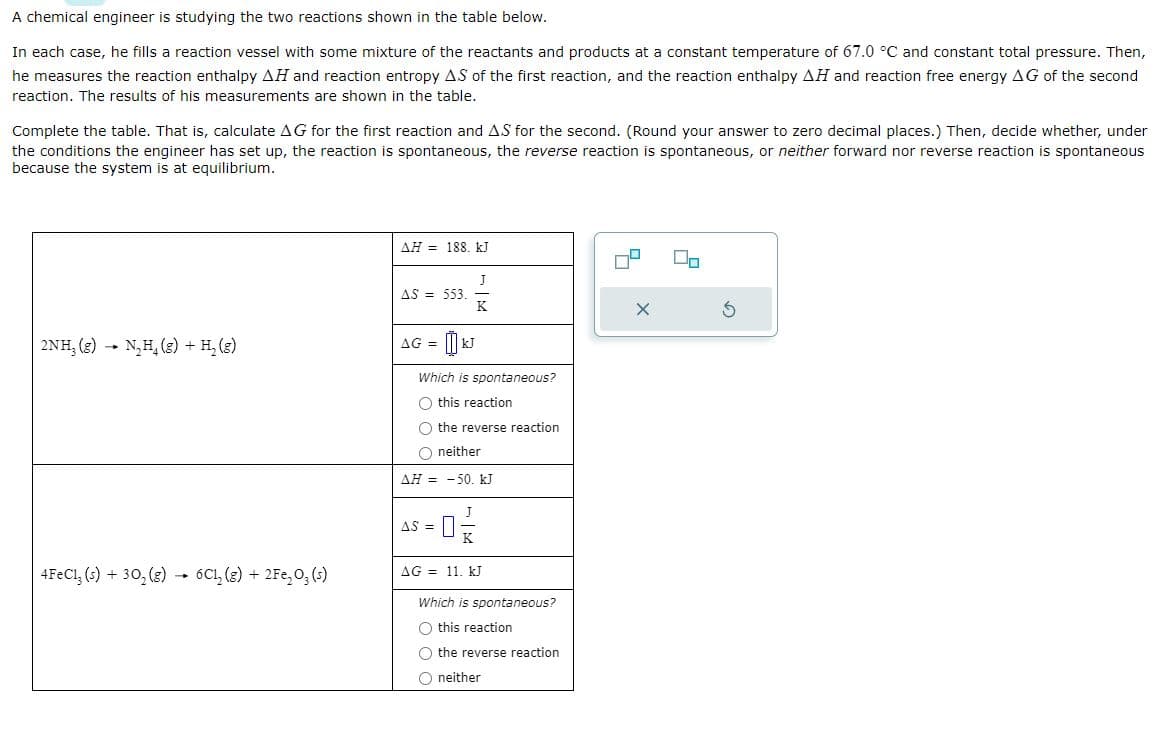A chemical engineer is studying the two reactions shown in the table below. In each case, he fills a reaction vessel with some mixture of the reactants and products at a constant temperature of 67.0 °C and constant total pressure. Then, he measures the reaction enthalpy AH and reaction entropy AS of the first reaction, and the reaction enthalpy AH and reaction free energy AG of the second reaction. The results of his measurements are shown in the table. Complete the table. That is, calculate AG for the first reaction and AS for the second. (Round your answer to zero decimal places.) Then, decide whether, under the conditions the engineer has set up, the reaction is spontaneous, the reverse reaction is spontaneous, or neither forward nor reverse reaction is spontaneous because the system is at equilibrium. 2NH₂(g) → N₂H₂(g) + H₂(g) 4FeC1₂ (s) + 30₂ (g) - 6C₁₂(g) + 2Fe₂O₂ (s) AH = 188. kJ AS = 553. J K AG = 1 kJ Which is spontaneous? O this reaction O the reverse reaction neither AH = -50. kJ AS = AG = 11. kJ Which is spontaneous? Othis reaction O the reverse reaction O neither 00
A chemical engineer is studying the two reactions shown in the table below. In each case, he fills a reaction vessel with some mixture of the reactants and products at a constant temperature of 67.0 °C and constant total pressure. Then, he measures the reaction enthalpy AH and reaction entropy AS of the first reaction, and the reaction enthalpy AH and reaction free energy AG of the second reaction. The results of his measurements are shown in the table. Complete the table. That is, calculate AG for the first reaction and AS for the second. (Round your answer to zero decimal places.) Then, decide whether, under the conditions the engineer has set up, the reaction is spontaneous, the reverse reaction is spontaneous, or neither forward nor reverse reaction is spontaneous because the system is at equilibrium. 2NH₂(g) → N₂H₂(g) + H₂(g) 4FeC1₂ (s) + 30₂ (g) - 6C₁₂(g) + 2Fe₂O₂ (s) AH = 188. kJ AS = 553. J K AG = 1 kJ Which is spontaneous? O this reaction O the reverse reaction neither AH = -50. kJ AS = AG = 11. kJ Which is spontaneous? Othis reaction O the reverse reaction O neither 00
Chemistry & Chemical Reactivity
10th Edition
ISBN:9781337399074
Author:John C. Kotz, Paul M. Treichel, John Townsend, David Treichel
Publisher:John C. Kotz, Paul M. Treichel, John Townsend, David Treichel
Chapter18: Principles Of Chemical Reactivity: Entropy And Free Energy
Section18.7: The Interplay Of Kinetics And Thermodynamics
Problem 2.2ACP: It has been demonstrated that buckminsterfullerene (C60), another allotrope of carbon (Section 2.3),...
Related questions
Question

Transcribed Image Text:A chemical engineer is studying the two reactions shown in the table below.
In each case, he fills a reaction vessel with some mixture of the reactants and products at a constant temperature of 67.0 °C and constant total pressure. Then,
he measures the reaction enthalpy AH and reaction entropy AS of the first reaction, and the reaction enthalpy AH and reaction free energy AG of the second
reaction. The results of his measurements are shown in the table.
Complete the table. That is, calculate AG for the first reaction and AS for the second. (Round your answer to zero decimal places.) Then, decide whether, under
the conditions the engineer has set up, the reaction is spontaneous, the reverse reaction is spontaneous, or neither forward nor reverse reaction is spontaneous
because the system is at equilibrium.
2NH₂(g) → N₂H₂(g) + H₂(g)
4FeC1₂ (s) + 30₂ (g)
6C₁₂(g) + 2Fe₂O₂ (s)
AH = 188. kJ
AS = 553.
AG =
J
K
Which is spontaneous?
O this reaction
O the reverse reaction
Oneither
AH = -50. kJ
AS =
02
AG = 11. kJ
Which is spontaneous?
Othis reaction
O the reverse reaction
O neither
00
Expert Solution
Step 1
If for a reaction
∆G= -ve => forward rxn is spontaneous
∆G= +ve => reverse rxn is spontaneous
∆G= 0 => rxn is in equilibrium.
Step by step
Solved in 3 steps with 2 images

Recommended textbooks for you

Chemistry & Chemical Reactivity
Chemistry
ISBN:
9781337399074
Author:
John C. Kotz, Paul M. Treichel, John Townsend, David Treichel
Publisher:
Cengage Learning

Chemistry: The Molecular Science
Chemistry
ISBN:
9781285199047
Author:
John W. Moore, Conrad L. Stanitski
Publisher:
Cengage Learning

Principles of Modern Chemistry
Chemistry
ISBN:
9781305079113
Author:
David W. Oxtoby, H. Pat Gillis, Laurie J. Butler
Publisher:
Cengage Learning

Chemistry & Chemical Reactivity
Chemistry
ISBN:
9781337399074
Author:
John C. Kotz, Paul M. Treichel, John Townsend, David Treichel
Publisher:
Cengage Learning

Chemistry: The Molecular Science
Chemistry
ISBN:
9781285199047
Author:
John W. Moore, Conrad L. Stanitski
Publisher:
Cengage Learning

Principles of Modern Chemistry
Chemistry
ISBN:
9781305079113
Author:
David W. Oxtoby, H. Pat Gillis, Laurie J. Butler
Publisher:
Cengage Learning

Chemistry: Principles and Practice
Chemistry
ISBN:
9780534420123
Author:
Daniel L. Reger, Scott R. Goode, David W. Ball, Edward Mercer
Publisher:
Cengage Learning

Chemistry & Chemical Reactivity
Chemistry
ISBN:
9781133949640
Author:
John C. Kotz, Paul M. Treichel, John Townsend, David Treichel
Publisher:
Cengage Learning
